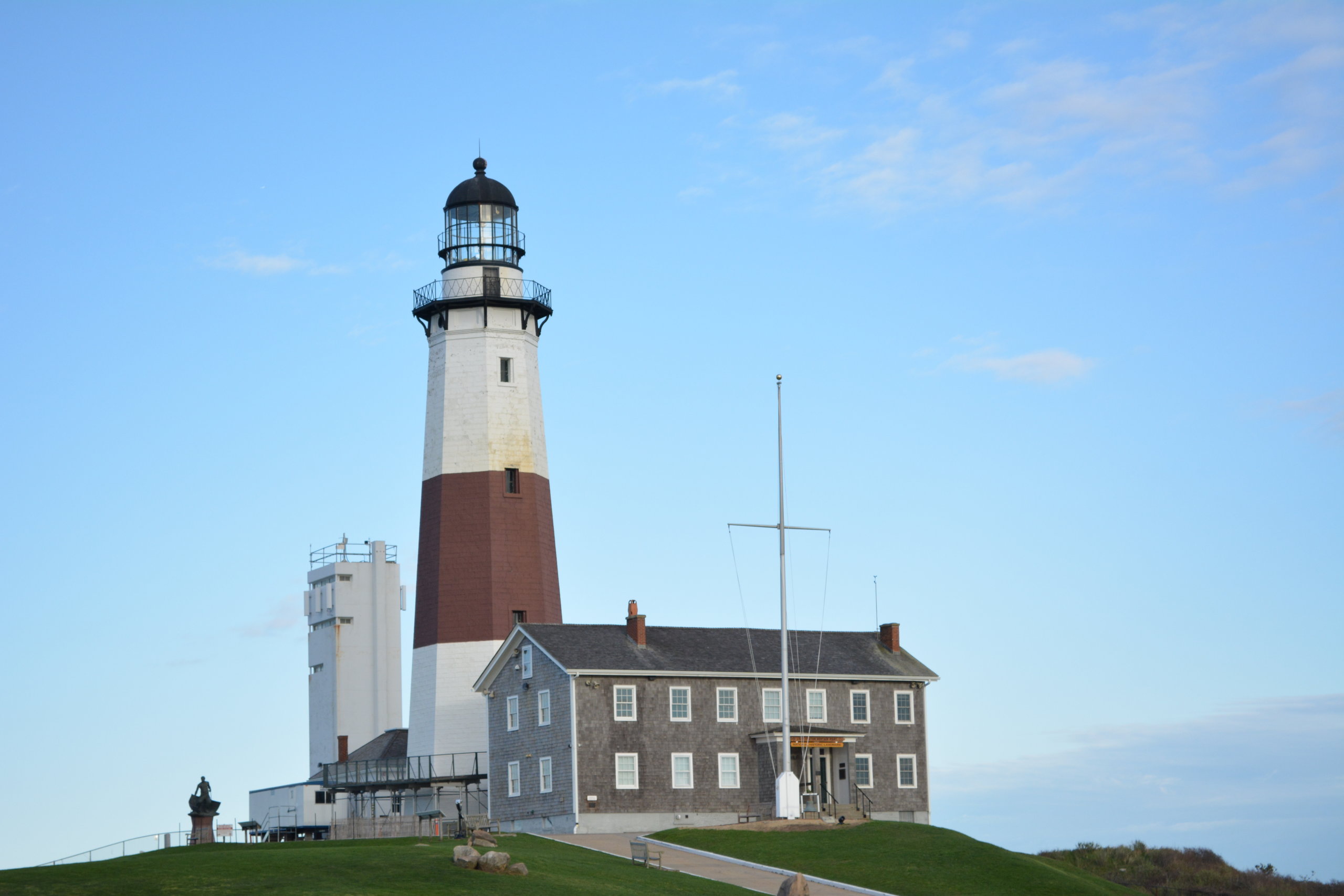$44 Million Fortification Project Completed on Montauk Point Lighthouse

When Montauk Historical Society President Joseph Gaviola stepped to the microphone at an August 16th press conference announcing the completion of a two-year, $44 million project to fortify the shoreline surrounding the historic Montauk Point Lighthouse, he held a laminated document in his hand.
With the kind of reverence for the past that no one musters quite like a historian, Gaviola informed attendees that he was holding the original proclamation authorizing construction of the lighthouse. The document was dated 1792 and signed by President George Washington.
Construction ultimately began in June, 1796 and was completed five months later in November of that same year by John McComb, the man who also built Gracie Mansion.
At the end of 1796, the storied maritime beacon stood on a bluff just a shade less than 300 feet from the water’s edge. Today, erosion has cut that buffer distance down to less than 100 feet.
Without fortification, the Montauk Point Lighthouse was destined to slide into the sea.
Designed to protect the historic site from waves, coastal storms, erosion and the intensifying effects of climate change, the restoration project was performed by the U.S. Army Corps of Engineers in conjunction with the New York State Department of Environmental Conservation. The project consisted of the reconstruction and reinforcement of approximately 1,000 linear feet of stone revetment (retaining wall), which was originally built in 1991 by the U.S. Coast Guard to fortify the shoreline.
There was plenty of heavy lifting involved, including the removal and reuse of existing armor stones, and delivery and placement of massive new armor stones weighing anywhere from 10 to 20 tons apiece.
The project was jointly funded by the federal government, which contributed $28.7 million toward the $44 million restoration, and New York State, which contributed the remaining $15.4 million.
In addition to the shoreline fortification work, the lighthouse itself also received a nip and a tuck. The Montauk Historical Society announced that it had completed $2 million in renovations, which included work on both the main building and the keeper’s residence, fixing damage to the stone façade and helping to secure the long-term structural integrity of the historic site.
Praise for the project poured in from state and local officials of all pay grades:
Gov. Kathy Hochul: “New York State is proud to complete this project with the U.S. Army Corps of Engineers to implement this critical shoreline resiliency project so that the beautifully renovated lighthouse buildings and grounds are protected and enjoyed for generations to come.”
Senate Majority Leader Chuck Schumer: “I thank Governor Hochul, the New York State DEC, and Suffolk County for their partnership, and of course the Army Corps of Engineers for its diligent work over many years to secure this magnificent structure. Now, one of our great jewels shining proudly on Long Island’s coastal crown will remain in place for years to come, and it ‘shore’ is pretty.”
State Senator Anthony Palumbo: “The Montauk ighthouse is an important symbol of the region’s maritime history and a beacon for the East End’s tourism and fishing industries. I applaud the efforts of our state and federal partners in protecting and preserving this historic landmark for future generations of New Yorkers and for visitors from around the world.”
Assemblymember Fred W. Thiele Jr: “The Montauk Lighthouse has been the iconic symbol of Long Island for generations. I was pleased to play a role in the public/private partnership that made this project possible by passing needed legislation many years ago in the State Legislature. My congratulations to the Montauk Historical Society for their vision and advocacy in seeing this project to its successful completion.”
East Hampton Town Supervisor Peter Van Scoyoc: “The Montauk Lighthouse, where the sun first rises on New York State, is not only an iconic symbol for New York but is a cherished landmark in the Town of East Hampton, representing a part of our nautical history stemming back to the early days of our nation. Thanks to major federal and New York State funding, and the efforts of the Montauk Historical Society, the Army Corps of Engineers and the contractors who completed this massive project of restoring the stone revetment that protects it, the lighthouse will be here for generations to come.”

The Dissenter
The event was decidedly celebratory, designed to herald the completion of a major fortification project performed to shore up the resiliency of an iconic and beloved East End structure.
But not everybody walked away happy.
“What just took place on Montauk Point is not consistent with any of New York State’s coastal policies. It does not comply with them and it should not have been done,” says Steven Resler, former Deputy Bureau Chief of New York State’s Coastal Management Program, an agency tasked with providing a set of enforceable policies to be followed by state and federal agencies when undertaking actions that affect coastal areas.
Resler argues that the more prudent plan would have been to physically move the lighthouse some 300 to 500 feet back away from the bluff toward the parking lot — a plan he claimed would ultimately cost fewer taxpayer dollars and result in increased security for the historic beacon.
“Moving the lighthouse back would keep it in Montauk State Park in a place where it would last several hundred more years,” Resler says. ‘It would not cost as much to move it as it will ultimately cost to maintain the revetments. It’s been done on Cape Hatteras; it’s been done in Cape Cod; it’s been done in Maine; it’s been done all over the country without spending hundreds of millions of dollars, which is what it’s eventually going to require to try to maintain the bluff in place as everything around it recedes.”
Resler was known as something of a maverick during his decades as a state official, and his opinions are often challenged by policymakers and engineers from multiple government and private sector agencies. Nevertheless, his argument is far from spurious, and it’s based on defensible science and public policy.
To focus on the fate of an individual structure like the lighthouse, however important it might be to the local zeitgeist, is to miss the bigger picture. Resler points out that the overriding philosophy of New York State coastal policy calls for moving, rather than maintaining, threatened structures in place.
“We have to engineer the shoreline in places like New York City, where we have massive investments in public and private infrastructure, and there’s no place to move out of harm’s way,” he says. “The other 80-plus percent of the coast is shifting, it’s moving, it’s sandy. We can’t hold it in place or everything we hold dear — the physical, the biological, the recreational, the aesthetic values of the coast, will disappear.”
Arguments like Resler’s shine a light on the inevitable policy clashes that are already occurring and are all but certain to occur more frequently as climate change accelerates beach erosion up and down the coast of New York State and around the world.
In the meantime, Long Island’s most iconic structure stands in place — well protected, at least for now.









